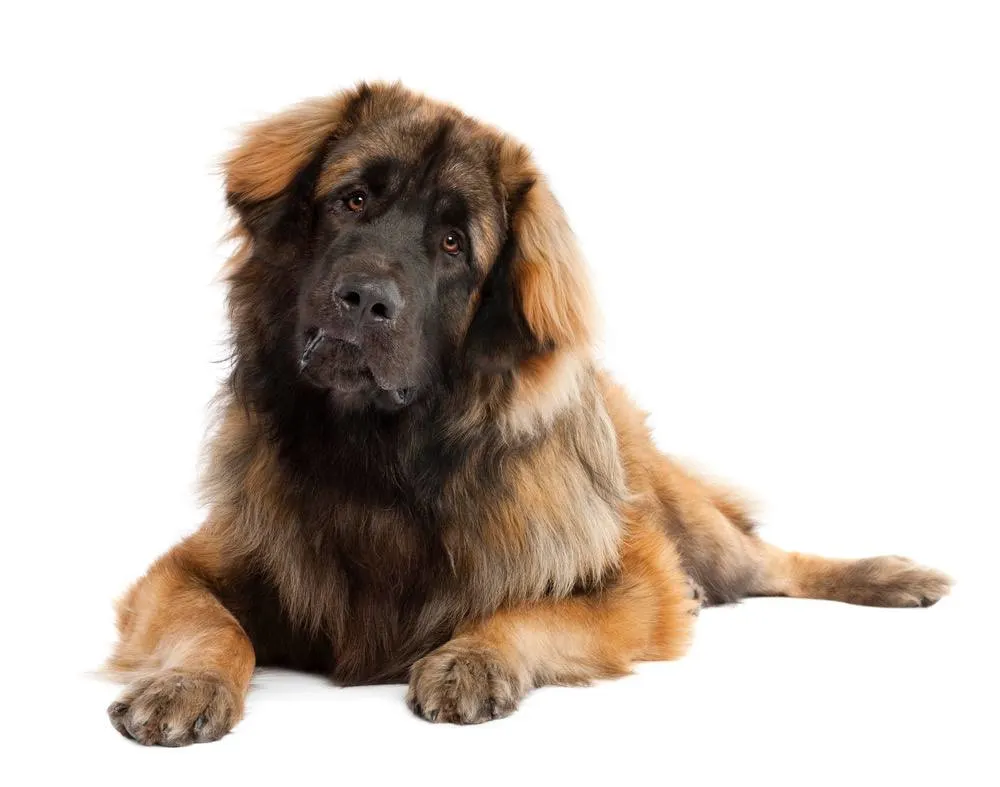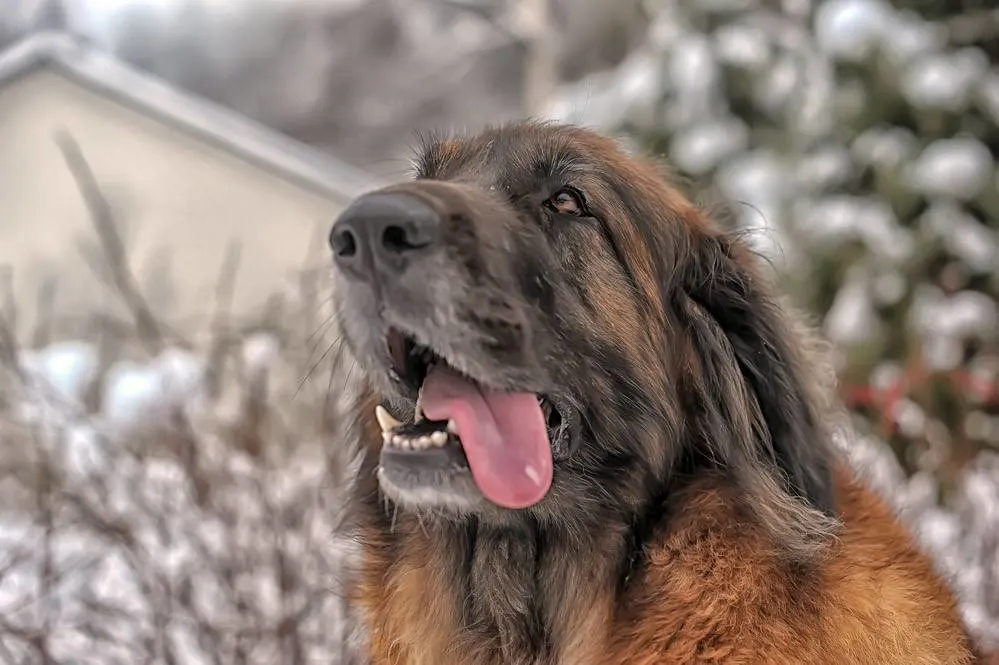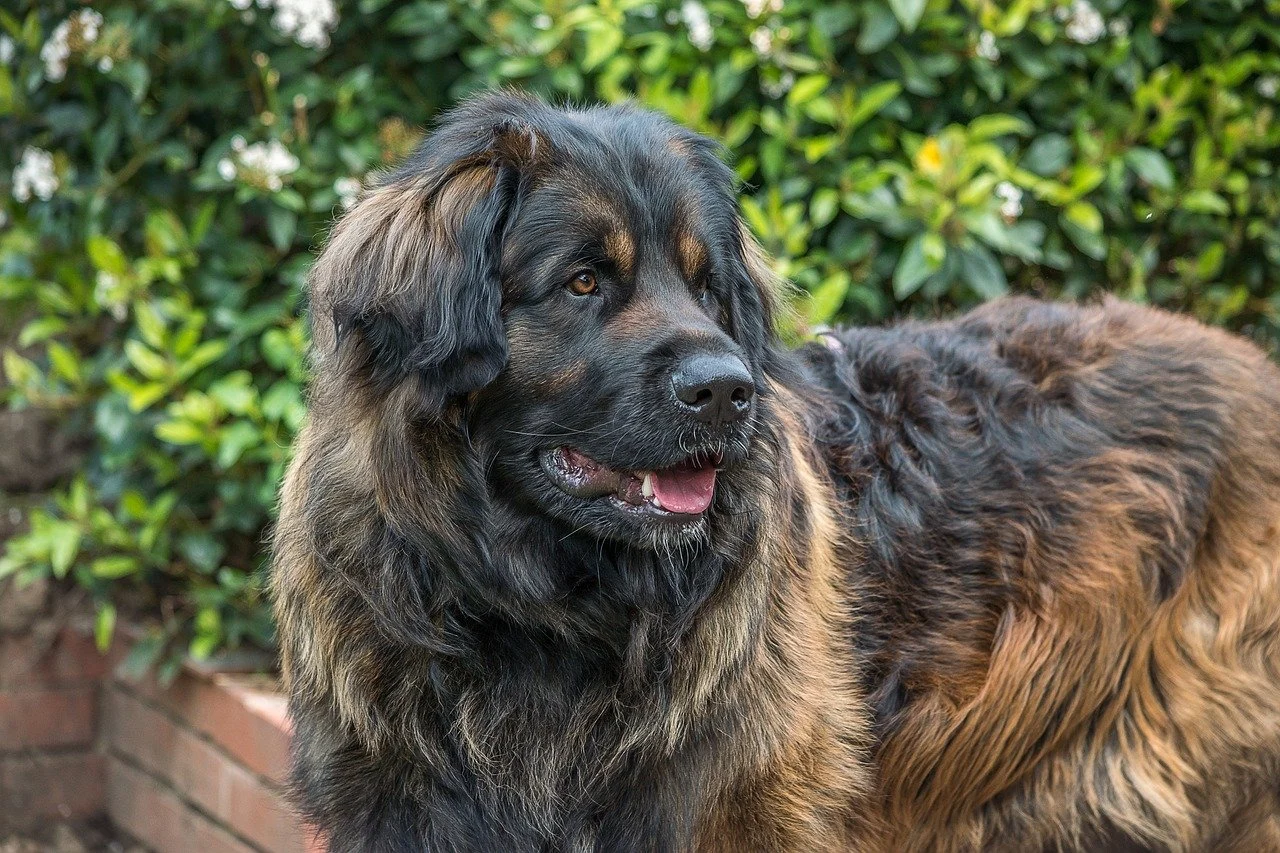Leonberger is a strong and powerful dog with a famous aristocratic stance. German politician and entrepreneur of Leonberg (Germany) Heinrich Essig was the father of the breed. Essig wanted to create a dog fit for a king. To do this he crossbred some of the largest working breeds, Newfoundlands, Saint Bernards, and Great Pyrenees.
The Leonberger, or Leo, is a large size dog with a friendly personality and a hardworking attitude. He is named after the city in Germany where it was bred. Despite the fact that the species was on the verge of extinction during World War II and I, it was thankfully rescued, as the breed is intellectual, noble, and devoted.
Leonbergers are great working dogs, as well as calm and loving friends. Mature males grow a thick lion-like mane, which adds to their distinct appearance. Even though some people believe the dog appears more bear-like.

Leonberger
History of the Leonberger
Leonbergers are a German dog breed that originated in Leonberg. Heinrich Essig claimed to have mated a Landseer Newfoundland and a St. Bernard numerous times and then crossed the progeny with a Pyrenean mountain dog in the mid-1800s.
Other dog breeds are thought to have been bred with early Leonbergers over time, but no documented records exist. The dog’s looks were bred to look like the lion on Leonberg’s town crest. And thanks do their lionlike mane and giant body type, they really did. In France, Austria-Hungary, Germany, and Italy, the breed became popular in royal and imperial houses.
The first dogs registered as Leonbergers were born in 1846 and had many of the desired traits of the breeds from which they were bred. In 1891, the first Leonberger clubs were formed by breed owners. They were common agricultural dogs who pulled carts. During both World Wars, they were employed to haul ammo wagons. During World War I, the breed was on the verge of extinction until it was salvaged by a handful of enthusiasts.
In the early 1900s, the Leonberger first emerged in the United States and Canada. The Canadian government brought them into work as water rescue dogs.
During the Great Depression, the breed became extinct in the United States. Leonberger numbers have risen steadily in Europe and, later, in the United States. Their national breed club, the Leonberger Club of America was founded in 1985. But it wasn’t until 2010 that the breed was formally accepted into the American Kennel Club AKC working group.

Leonberger
Leonberger Physical Characteristics
Leonbergers are a sexually dimorphic breed, which means that males and females of the breed are easily distinguishable. The female bodyline is more elegant and thin, with smaller hips and shoulders. Males have thicker coats and bigger heads and paws, as well as a noticeable mane on their heads and paws.
Leonbergers are distinctive, regardless of gender. Standing over 2 feet tall and well-muscled, a well built Leo regularly weighs over 100 pounds. With females reaching 140 pounds and male adolescent leos reaching 170 pounds. Male Leonbergers have a distinctive Leonberger mane around their necks, and their coats are medium in length with feathering at the chest, stomach, and tail. A thick undercoat lies beneath, giving them a fluffier, shaggy look.
Their coat colors come in a range of lighter tones, ranging from yellow and gold to light browns and red. Colors are mostly solid, with the exception of the breed’s signature black mask on the face and ears, which gives them a thoughtful, kind look. Their eyes are huge and almond-shaped, and they are all the same dark brown color. They have floppy, triangular ears.
Personality & Temperament
These dogs are huge cuddlers. Leonbergers were developed to be giant family dogs and are warm-hearted, sociable, and affectionate.
The breed has been traditionally socialized to the point that it is suitable for all types of households, including those with little children. Children under the age of ten should always be monitored because Leonbergers, no matter how gentle they are, are still 170-pound dogs that may knock over an unsuspecting youngster.
Their loving temperament also makes them ideal therapy dogs, according to the Leonberger Club of America, which they are eager to fill in senior centers and hospitals. There are presently over 100 Leonbergers working as therapy dogs in the United States. Huge hugs are ideal for their thick manes!
These dogs have the most wonderful personalities. They are people dogs and were bred to be your companion. But Leonbergers can be easily trained to get along well with other dogs too, especially if they are socialized as puppies. Cats are no problem for them either as long as they were raised with them.
The agile Leonberger isn’t exactly a loner because he was raised as a working dog who was expected to spend his days in the fields with his companions. He adores his family members and wants to be around them. If these puppies are left alone for long periods of time, they will struggle. Expect your neighbors to inform you about all the howling coming from your house if you’re going to be gone from them for more than a few hours at a time.
Furthermore, while they form a wonderful visual barrier to any would-be intruders—and are eager to bark an alarm bark with their booming voices—Leonbergers are enormous sweeties by nature when meeting new people. They have unlimited love to offer to anyone!

Leonberger
Health of the Leonberger
Unfortunately, the life span of these dogs isn’t that long. Leonbergers only survive to be approximately 7 years old because of their enormous size. Obesity, stomach dilatation, and volvulus will be the most prevalent everyday concerns for Leonbergers. If you don’t give them enough exercise, the former will become an issue, while the latter is a prevalent disease in breeds with huge chest chambers.
Long-term, the breed has a history of cancer problems, notably bone cancer, but it usually strikes Leonbergers in their latter years. Hip dysplasia has been a rare occurrence in the breed, but you should be aware of it and do all of the recommended health exams.
You also don’t want them to put on much size too quickly too. So making sure they’re on a well-balanced puppy diet is vital. Putting on too much weight too soon can cause joint problems and bones that aren’t fully grown.
Like other huge breeds, there is some debate among vets regarding when a Leonberger should be spayed or neutered. Because of the Leo’s great size and the possibility of stress on growing bones, the dog’s growth plates close later than those of smaller breeds.
Removing any of the organs in a dog’s body that monitor or regulate hormones can alter how that dog grows. There’s a theory that waiting until a large breed dog is closer to adulthood is preferable.
Most common health problems
Obesity
Obesity in dogs can be a serious health issue. It’s a dangerous condition that can lead to or exacerbate joint pain, metabolic and digestive difficulties, back discomfort, and heart disease. When he looks at you with those soulful eyes, it’s tempting to offer him food, but you can “love him to death” with leftover human food and doggie goodies. Rather than one large meal, give your dog a few smaller ones during the day. That will help him stay fit while still enjoying food. And don’t forget that these dogs need a good deal of exercise.
Bloat
Gastric Dilatation and Volvulus (GDV or Bloat) is a condition that affects dogs with deep, narrow chests. This indicates that your dog is more vulnerable than other breeds. The stomach twists on itself and fills with gas when a dog bloats. The twisting cuts off the stomach’s and sometimes the spleen’s blood flow. If left untreated, the sickness can kill your dog in as little as 30 minutes. Your dog may retch or heave (but nothing comes out), be agitated, have an enlarged abdomen, or lie in a prayer position (front feet down, rear end up). Preventive surgery, which involves tacking or suturing the stomach in place so that it does not twist, is a good option.
Hip Dysplasia
Canine hip dysplasia occurs when the hip joint becomes unstable as a result of both developmental and environmental factors. Dogs are prone to this bone and joint disorder. The femur does not meet the pelvic bone appropriately, causing the bones to wear out prematurely.
Later in life, your dog may develop arthritis, which can be excruciatingly painful. This ailment shows itself as a peculiar walk, shaky posture, or limping, all of which are plainly seen in your beautiful pup. To preserve your dog’s quality of life, discuss care with your veterinarian as soon as possible.
Leonberger polyneuropathy
Leonbergers can develop a genetic neurological condition known to veterinarians and breeders as “inherited polyneuropathy (IPN)” or “Leonberger polyneuropathy (LPN).” Affected dogs acquire exercise intolerance over time and may develop movement abnormalities, such as an excessively hitched walk, especially in the hind limbs. Muscle atrophy in the rear limbs is also common. Due to the involvement of the larynx and laryngeal folds in the throat, these dogs may have loud breathing, a change in their bark, or even difficulties breathing. The condition may eventually worsen to the point where the dog is unable to support its own weight.
Heart disease
Heart disease is the major cause of mortality in senior Leonbergers. The majority of heart disease in dogs is caused by the weakening or slow distortion of heart valves, causing blood to seep back around the weakened valves, putting strain on the heart. Heart valve disease (also known as mitral valve disease) causes a heart murmur in pets. Weight control and veterinary care can help avoid heart disease, in addition to a healthy lifestyle.
Bone cancer
Osteosarcoma is a severe bone cancer that primarily affects large and giant breeds. Lameness is the first indicator of osteosarcoma, but x-rays will be required to determine whether the reason is malignancy. Osteosarcoma is usually treated aggressively, with limb amputation and chemotherapy. Dogs can live for nine months to two years or more with treatment. Fortunately, dogs adjust well to life on three legs and do not have the same chemotherapy side effects as people, such as nausea and hair loss.
Caring for a Leonberger
Living with a Leonberger in a small apartment is like living with a 170-pound roommate who has dubious views on personal space. Leonbergers, on the other hand, are adaptive pups that can adjust to live anywhere as long as you provide them with the activity they require.
Leonbergers get along well with other pets. They prefer to be in small groups with other Leonbergers, but they are normally fine with smaller dogs or even cats too. The gentle-natured Leo is especially well-suited to families with children, however, as with any dog, playing with small children should always be supervised. Leonbergers also prefer being among senior citizens and enjoy being a couch potato, as long as he gets at least one or two daily walks.
Exercise
Leonberger is a large dog and it needs a lot of play and private space. Therefore, if you own a small apartment or a house without a spacious backyard, this dog is not for you. Leonbergers are generally calm dogs, but they still need regular daily walks and exercise to stay healthy and happy. Leos are working dogs, so they will enjoy pulling a cart.
Experts recommend two 30-minute walks every day and additional 60 minutes of free play for your Leo. These active dogs also enjoy hiking, jogging, and swimming. The breed is built for swimming, with higher lung capacity, webbed feet, and a waterproof coat.
Leos can withstand cold weather well, but they can become overheated in warmer weather because to their thick double coats. In hot weather, it’s a good idea to offer a cool spot for a Leo and limit exertion to the cooler hours of the day.
Grooming
Leonbergers can be difficult to groom. Their strong undercoat and thick, medium-length hair are constantly shedding. They’ll shed that undercoat fully twice a year. Resulting in an extra load of fur on the floor in the spring and fall.
Owners will need to brush their Leo on a regular basis. Brushing this dog, which is larger than the average high school freshman, will take time. Grooming these guys will become a pastime. Bathing will probably take place once or twice a month. On the positive side, all that shedding and grooming keeps the Leonberger’s coat from becoming excessively long, allowing trips to the groomer to be avoided.
Leonbergers, like other dogs, need to have their nails clipped so that they don’t click-clack over the floor. Their ears should be examined and cleaned as well.
Nutrition
Giving Leonbergers breed-specific formulae that fit their demands as a big breed is the best option. Leonberger pups can be fed multiple times a day. They will reach a weight of over 100 pounds by the time they reach their first birthday. Ensure that fresh drinking water is always available.
To avoid bloating and GVD, adult Leonbergers should be fed twice a day. Provide raised feeding bowls so your dog may eat and drink while standing up to reduce the chance of stomach torsion. Look for a feeding bowl that restricts the amount of food your dog may take at once if your dog is prone to gulping. After a meal, you should avoid intense movement for an hour.
Trainability
Early socialization and proper training are a must if you want to have a well-rounded dog. Leonbergers are intelligent and eager to please so training them shouldn’t be a big problem. Use positive reinforcement methods, treats, praise, and rewards for best results.
They are extremely sensitive creatures because of their intense people-pleasing tendencies. Leonbergers, like all dog breeds, benefit from plenty of positive reinforcement when it comes to obedience training.
Getting a Leonberger puppy
You could possibly locate a Leonberger at a local animal shelter. But a Leonberger rescue group committed to rescuing and rehoming unwanted, abandoned, or mistreated Leonbergers and Leonberger mixes is more likely to have this dog for you. A purebred Leo puppy can cost anywhere from $1,500 to $4,000 if you want to deal with a breeder.
Here are some websites to get you started on your hunt for a Leo puppy.
Credit: Photo by depositphotos.com

